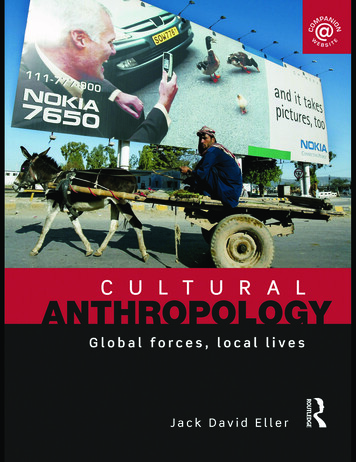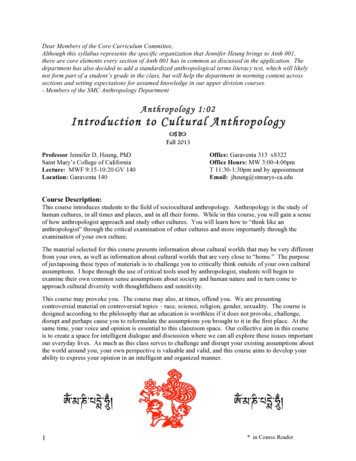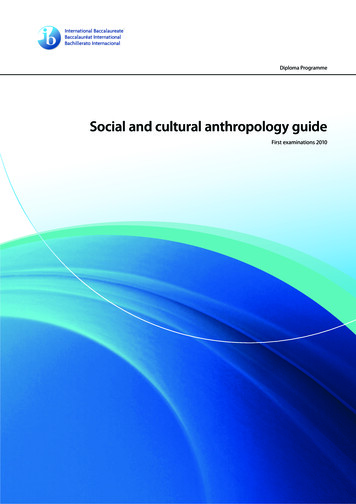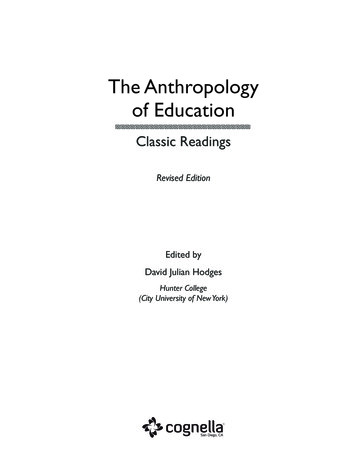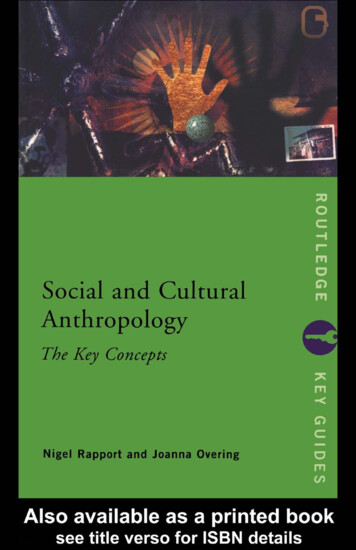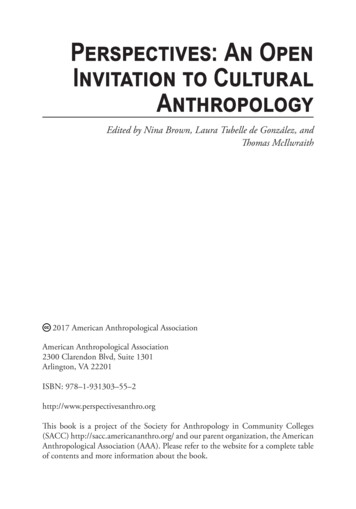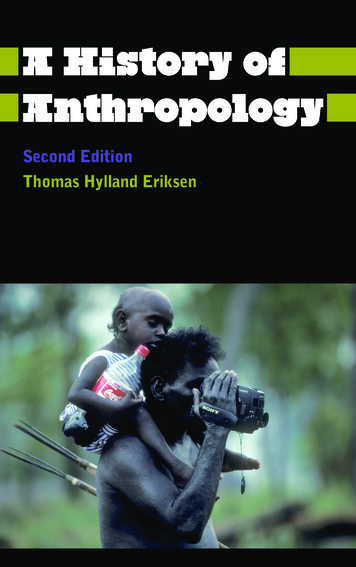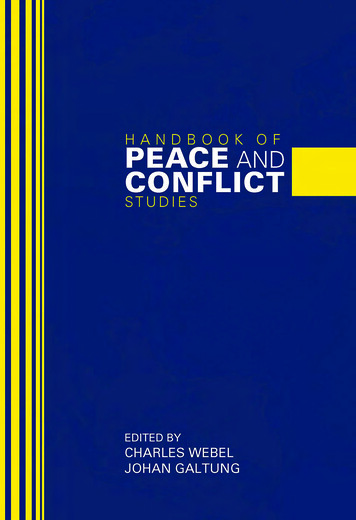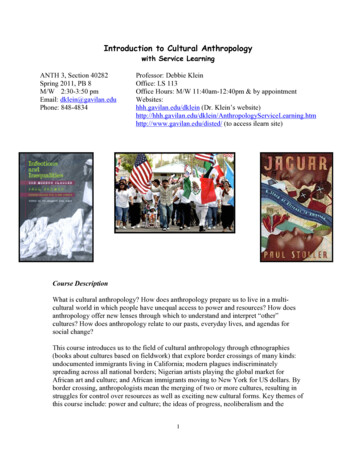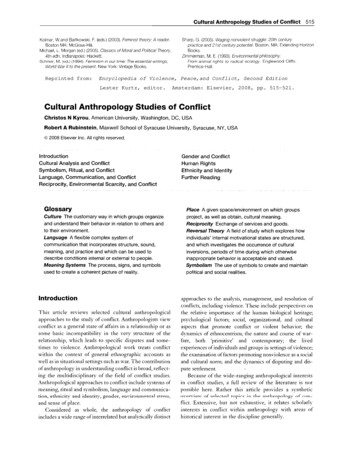
Transcription
Cultural Anthropology Studies of ConflictKolrnar, W.and Bartkowski,F. (eds.)(2003).Fem nlsttheow: A reader.Boston MA: McGraw-Hill.Theow,Mlchael, L. Morgan (ed.)(2005).Class csof Moral and Poiit cal4th edn. Indianapol s:Hackett.Schneir, M. jed.) (1994). Fem n sm nour t me:The essent alwnt ngs,World War /Ito the present. New York: Vintage Books.Reprinted from:515Sharp, G. (2005).Waging nonv olentstruggle: 20th centuwpractice and 21st centuwpotent ai.Boston, MA: Extend ngHorizonBooks.Zirnrnerman, M. E. (1993).Environmentalphilosophy.From animal rights to rad calecology Englewood Cliffs:Prent ce-HallEncyclopedia of Violence, Peace,and Conflict, Second EditionLester Kurtz, editor.Amsterdam: Elsevier, 2008, pp. 515-521.Cultural Anthropology Studies of ConflictChristos N Kyrou, American University, Washington, DC, USARobert A Rubinstein, Maxwell School of Syracuse University, Syracuse, NY, USAO 2008 Elsevier Inc. All rights reserved.lntroductionCultural Analysis and ConflictSymbolism, Ritual, and ConflictLanguage, Communication, and ConflictReciprocity, Environmental Scarcity, and ConflictGlossaryCulture The customary way in which groups organizeand understand their behavior in relation to others andto their environment.Language A flexible complex system ofcommunication that incorporates structure, sound,meaning, and practice and which can be used todescribe conditions internal or external to people.Meaning Systems The process, signs, and symbolsused to create a coherent picture of reality.lntroductionGender and ConflictHuman RightsEthnicity and IdentityFurther ReadingPlace A given spacelenvironment on which groupsproject, as well as obtain, cultural meaning.Reciprocity Exchange of services and goods.Reversal Theory A field of study which explores howindividuals' internal motivational states are structured,and which investigates the occurrence of culturalinversions, periods of time during which otherwiseinappropriate behavior is acceptable and valued.Symbolism The use of symbols to create and maintainpolitical and social realities.This article reviews selected cultural anthropological.approaches to the study of conflict. Anthropologists viewconflict as a general state of affairs in a relationship or assome basic incompatibility in the very structure of therelationship, which leads to specific disputes and sometimes to violence. Anthropological work treats conflictwithin the context of general ethnographic accounts aswell as in situational settings such as war. T h e contributioilof anthropology in understanding conflict is broad, reflecting the multidisciplinary of the field of conflict studies.4nthropological approaches to conflict include systems ofmeaning, rinial and symbolism, language and communica-approaches to the analysis, management, and resolution ofconflicts, including violence. These include perspectives onthe relative importance of the human biological heritage;psycl ological factors; social, organizational, and culturalaspects that promote conflict or violent behavior; thedynamics of ethnocentrism; the nature and course of warfare, both 'primitive' and contemporary; the livedexperiences of individuals and groups in settings of violence;the examination of factors promoting nonviolence as a socialand cultural norm; and the dynamics of disputing and dispute settlement.Because of the wide-ranging anthropological interestsin conflict studies, a f i l l review of the literature is notpossible here. Rather this article provides a synthetiction, ethnicity and identity, gender, environmel talstress,n v e r r i e r unf elerteclrnr;rqand sense of place.Considered as whole, the anthropology of conflictincludes a wide range of interrelated but analytically distinctflict. Extensive, but not exbaustive, it relates scbolarl)interests in conflict within anthropology with areas ofhistorical interest in the discipline generally.inrhe n r h r n n nfl n r n n-
516Cultural Anthropology Studies of ConflictCultural Analysis and ConflictEdward Tylor's definition of culture in 1871 as a "complex whole which includes knowledge, belief, art, nlorals,law, custom, and any other capabilities and habitsacquired by man as a member of society" was embeddedon the basic belief that humans were bound by a "psychicunity," that people's minds everywhere operated thesame way and all people had the same potential fordevelopment.Evolutionary thought dominated much of early anthropology from the late nineteenth through the early part ofthis century largely through the efforts of Americananthropologist, Lewis Henry Morgan.By the 1520s anthropological thought had developed asubstantial critical reaction to evolutionary models ledearlier, largely by Lewis Henry Morgan. In the UnitedStates, Franz Boas developed historical particularisn sought group cultures only within broad categories of"cultural areas" on the basis of shared traits that oftenreflect adaptive responses to natural environments. Thesegroupings, however, provided no explanatory model, onlya means of comparison.At the same time period, British hnctionalists optedfor detailed studies that artenlpted to understand 'primitive' culture on its own terms. Alfred Radcliffe-Brown andBronislaw Malino\vski, understood culture in moremechanical terms and took as their metaphor the livingorganism. Like any organism, it is the individual parts of aculture - specific customs or institutions - that are interconnected and 'function' to maincain che total system.Functionalism, however, treated cultures as closedsystems in timeless equilibrium, despite ongoing changeand contact with other cultures. Furthermore, tautolugically, cultural traits were explained by their fiinctions,which in turn were explained by the traits.Today anthropologists recognize that 'culture' consistsof both structures and patterns that orient what people seeas the important physical and social elements in theirworld, establish norms for proper and improper ways ofacting, and create emotional patterns which contribute toindividual nlotivation. Anthropologists recognize that thesestructures and patterns vary within a society and that theyare interdependent, thus constituting culture as emergentin the sense that it is always being reproduced and revised.Linkage between these 'levels' of organization is madethrough the study of meaning. An emphasis is placed onunderstanding social patterns and institutions in terms ofhow people make their daily experiences meaningful andproductive. 'Meaning-centered' approaches can be tracedto the mid-1950s and 1960s and shifts toward anchropological approaches to the s n d yof synlbols and symbolism.By using the culture-as-meaning approach, anthropologists have collected information on institutions, rituals,norms, and other cultural patterns and processes. 'Thisapproach has allowed them to better undurstand howthese dimensions of humail and social life relate to colleccive violence and co social viulence in general.T h e main cases where anthropology has focused primarily on social conflict and collective violence includeearly on the so-called primitive warfare, in the 1570smainly, ethnocentrism and human universals, and rnorerecently the effects of violence on individuals and groups,Furthermore, anthropology in conflict studies growsthrough the increasing use of ethnographic study as an1ethodology of choice in research with combined rnrthods design for other fields such as psychology, sociology,and international relations.For example, in the 1580s, a focus on issues regardingthe threat of global destruction through thermonuclearmeans produced literature theorizing on the concept ofrisk-taking and its associated behaviors. Margaret Clarktraced four traditional motivations for "risk-seeking:" theelements of play, the involvement of social stratification,the incorporation of supernatural elements, and finallythe promise for secular rewards. She provided examplesof rituals, institutions, beliefs, and behaviors from a variety of cultures, including those with capacity to engage innuclear warfare, in order to expose the cultural patterns ofrisk-seeking in our society and show that radical changesare required to eliminate such patterns.In a similar analysis, Mary L. Foster demonstrated thatrisk-seeking behavior exists at the group level, as well asindividual level, where it is socially supported and collectively sanctioned through psychological reversals andcultural inversion. This concepnlal stnlcmre entailing periodical 'shifts of power' was developed by Gregory Batesonin order to explain the conciliation between the complementary (leader to follower) and the symmetrical (nie nbersof the same team) interaction, coexistiilg within societies.Douglas Fry's research demonstrates that conflict andviolence are not the result of inbred patterns. Rather heshows that conflict, violence, and war, and the management of these processes are the result of the complexinteraction of 'nature' and 'nurture'. Thus, we see thatparticipation in institutionalized forms of violence andcontlicc requires culturally patterned methods ofmotivation. iiTalterGoldschmidt traced the relationship betweenpersonal motivation and institutionalized conflict in bothtribal societies and the American society. Goldscllmidtsuggested that the benefits of such a career motivate theindividual to participate. Such benefits include enhancedsocial standing, social gratification, personal pride, prosperity, and strength. All of these contribute to preservingwhat he called "vicious cycle" between popular action andw 1 r C a r n l G r n h r n h:rci c I I P I P I r n r r c a c c r n i l i c r i c r nacsomething other than social disorder. Rather, she arguesthat when milicarism is understood as a component of thesame social order that keeps vital other social institutions
-such as religion, kinship, and the la\v, we are better able toexplain why joining the military is often an act that istaken for granted by many state societies.Symbolism, Ritual, and ConflictIn Anthropology both conflict and 1.iolence are understood as shaped in response to culturally specific norms,values, ideologies, and worldviews. What n otivatessocieties in conflict arises out of institutionalized socialinteractions that are mutually defined by members ofthat society. Often, however, the cultural knowledge thatforms the basis of what justifies contlict in one setting andcondemns it in another is taken for granted and is assumedto be an objective fact by the participants themselves.In terms of how conflict and violence are institutionalized within cultures, anthropologists have looked at waysin which conflict relations are maintained, expressed, oras is often the case, masked, by means of symbolism andsymbolic behavior. T h e early work of anthropologistAbner Cohen has proved particularly insightful for theunderstanding of the relationship between symbolism the expression or manipulation of symbolic forms andpatterns of symbolic action - and the struggle of groupsfor economic and political power.As Cohen argued, symbols do not arise spontaneously,but rather are produced through a process of continuousrestructuring in relation to the distribution of resourcesfound in society. T h e careful study of the interrelationship between these two domains yields importantinformation regarding motivations for conflict and violentbehavior.T h e study of ritual has provided a fertile territory foranalyzing the relationship between political struggle andsymbolic behavior. Political speeches, national demonstration, public executions, all examples of politicalritual, draw upon meaning structures and symbols toconvey powerful messages of legitimacy and to ensurethe mandate to exercise power. David Kertzer observesthat the meaningful content of ritual is encoded in sl-mbols. Symbols are the words through which rituaIs makesense to societies. T h e i r weight, sequence, and presence or absence - help to ensure that the message is delivered.In the realm ofpc litics,anthropologists note how symholsand symbolism generally operate in such a way to constructsocial unity where otherwise diverse interests and needs maybe present within a single society. Symbols are, in VictorTurner's words, "multivocal," thus any symbol or setof symbols can encode a variety of different meanings.Because they possess a certain "condensation" of meanings,feelings, and emotions, symbols can speak simultaneously topeople differently situated within society.More than carrying messages, symbols instignte socialaction and define an individual's place within society. InCultural Anthropology Studies of Conflict 51 7her exploration of Iranian popular culture, hlar).Catherine Bateson identifies different normative themesof choice-making, which she argues can affect intcrnational afhirs. Through an analysis of popular stories andfilms, Bateson draws a distinction between two Iranianapproaches to decision-making. O n e form is rooted inpragmatism and the rules of cornpromise and calculationand the other in the preservation of honor in spite of thepossible negative consequences. Bringing such h r m s tobear upon understanding international relations betweenthe United States and Iran demonstrate the future need tofocus on motivations rather than simply the outcome forpolitical behavior. More recently, William 0. Beemanuses 3 discourse analysis approach to show how theUnited States and Iran have engaged in a cycle of mutualdemonizaition and misunderstanding. In a wide-ranginganalysis, Beeman shows how each side automatically discounts the presentations of the other simply because whatis being said comes from the other side. This process,called reactive devaluation, is a frequent element in escalating conflicts. As well, Beeman's analysis explicates thesymbolic bases for the mutual demonizing of the UnitedStates by Iran and vice versa. Beeman's analysis is especially relevant to the geopolitics of nuclear proliferationin the early twenty-first century.Language, Communication, and ConflictLanguage is a human universal - all people use a spokensymbolically based system of communication. Indeed, oneof the fundamental characteristics of culture is that it iscommunicated among its people. Language can createboundaries. It can signify membership in the same culture, or it can denote difference and play a serious role inframing the 'other'.E t h n o l i l p i s t i canalysis yields large amounts of oftensubtle information about the culture under study.Language, in the broad sense of the term, reflects one oranother element of a community's social life, includingsocial stratification, sense of space or time, and most of all,narration. For the study of conflict, esalnination of conlmunication patterns in society can illurninate the subtleways intracultural conflict is dealt with through language.In her study of the buladi women in Cairo, Evelyn Earlyexplores how quarrels between women serve as vehiclesfor the transmission of important cultural expectationsconcerning respectful and appropriate behavior; what isbeing said, when, and by whom, plays a decisive role inbaladi conflict management.Lawrence Fisher's study of the Barbadian cornmunication strategy of 'dropping remarks' demonstrates howb e y o thed speech act i r x l c c,lrcCul L L L I J L I J I I 1 1 1 u a t bcpaid to the context of discourse. Dropping remarks is asubtle form of a triangular speech event. 'They are
518Cultural Anthropology Studies of Conflicttriangular in the sense that speakers 'drop' insults to a targetindividual through conversations o\rerheard with a thirdparty not directly involved in the dispute. In other words,a speaker's intended audience is not the person directlyspoken to, but rather an onlooker. Dropping remarks operates to escalate dormant conflict that may or may not breakinto direct quarreling by allowing a speaker to state a ositionin a dispute. As aggressive acts that are packagedas relatively harmless, rhej- allow accusations to be madewithout leading to the necessity of outright quarrel.T h e study of ethnolinguists demonstrates how languagecan serve to both accelerate and ameliorate conflicts withinsocieties. Similarly, the study of language can reveal thesources of conflict between societies. Much of the scholarlywork on language and conflict between cultures has benefited from insights of anthropologist Edward Hall'sdistinction between 'high' and 'low' context speech communities. In the case of the former, discourse is indirect,with ideas often expressed in abstract and nietaphoricalform, and favoring broad frameworks rather than minutedetails. In contrast, low context represents comn unicationpredicated on the direct delivery of information, withoutambiguity, and often neglectful of particular idiosyncrasiesof communication styles.In an effort to account for the continued failures innegotiation between Israelis and Egyptians for nearly 50years, Raymond Cohen plumbs the social, cultural, andhistorical differences between the two cultures to demonstrate how different conceptions of time, the role ofviolence, and the community impede the negotiatingprocess. In addition to the contrast between a highcontext Egyptian communication style and an Israeliform of direct 'Ion,-context' discourse style, Cohen noteshow different conceptions of time inform the pace andschedule of negotiation.Looking at competing notions of argument and persuasion, Barbara Koch's analysis of rhetorical speech incontemporary Arabic texts shows that Arabic writers construct "proof' through such high-context forms ofpersuasion as repetition, paraphrasing, and the structuringof argumentative clain sin recurring syntactical patterns.This systematic valuing of linguistic forms and acnialwords in rhetorical speech, Koch claims, runs counter toWestern modes of discourse and rules of argument, whichprivilege the logical structure of arguments over the particular way in which they are packaged.Reciprocity, Environmental Scarcity, andConflict111 h e i r srudieh ufso-called sinlple s o c i c t i c s , c a d y a n t h r opologists noted a fundamental process where even smallsurpluses are shared with other members of a comn unity.This observation provoked anthropologists tu considerhow all surplus production is invested in human relationsand translated into social assets. T h e exchange of scarcegoods creates bonds of indebtedness between communitymernbers, which reinforces the cohesion of society. Thisprocess anthropologists label 'reciprocity'. In the historyof anthropology, reciprocity has become one of the erhnographic categories pdr excellence.'4s inhabitants ofecosystems, humans are vulnerable toenvironmental changes that threaten lifeways. Climatechange, for exarnple, has gradually driven populationsfrom one geographical region to another, in search forwhat ecologists term 'ecological niches', a new locationabundant in space and resources. In the rnodern era,migration due to social and environmental pressure hasbecome a fundamental force in the transformation, creation, and destruction of cultures.In studies of conflict, the concept of reciprocity hasbeen an important way to understand hour societiesnegotiate and adapt preexisting social relations to accommodate periods of resource scarcity brought about bythese changes. Under conditions of scarcity, social relations are at their most strained, calling upon a society'sability to adapt to new situations. Reciprocity oftenreflects a society's effort to convert a lack of econornicresources into a system of mutual assistance. Residents ofmarginalized communities, for instance, manage to survive by establishing social networks that ensure theexchange of goods, services, and information otherwiseunavailable in society. In her study of shantytown dwellers in Mexico City, Larrisa Lomnitz noted that patterns ofreciprocity were anchored in a series of spatially orientedclusters. Within each network, women engaged in dailyexchanges of favors, including borrowing food andmoney, assistance in child-rearing, and the exchange ofgossip. Men assisted each other in finding jobs, sharedlabor, and helped one another with expenses to coveremergencies and fund important community celebrations.Lo nnitzfound that "reciprocity frequently appears insituations that lack many alternatives and this is a sourceof its strength and persistence."Environmental stress, disaster, or prolonged scarcitymay challenge the adaptability of systems of reciprocity.Charles D. Laughlin and Ivan Brady reviewed the ethnographic evidence from societies undergoing suchenvironmental stress. T h e y foul d that under suchextreme conditions, the bounds of exchange and reciprocity may restrict, causing transactions to be more negativeand self-interested in nature. Colin Turnbull's study ofthe Ik in northeastern Uganda, a people who had experienced such severe and prolonged environmental scarcityprovides an u e r n p l a rnf rhnsr prncesse? Among rhr 1k.reciprocity relations had becorne so restricted that foodsharing between parents and their childre11 and betweenhusbands and wives had becollie the normative exception.
Cultural Anthropology Studies of ConflictThrough a broader definition of the en\-ironment, oneto include more than natural resources, anthropologistshave looked at the environment as a source and vehicle ofmeaning. l'im Ingold, in his work on ways that certain5atil.e American groups relate to space, demonstratedthat the natural en\.ironment can be a vehicle of meaning,not merely a canvas on which human cultures projecttheir own cultural constructs. One can argue that nature,seen in that manner, should be valued also as an autonomous spring of culture, instead of only natural materiel.T h e geographic overlap between cultural diversity on theplanet and biodiversity recorded by Garry Nabhan mayonly strengthen this point.Gender and ConflictCultures have systematized, ritualized, and even institutionalized women's unequal position to that of men inalmost every domain, from language to political power.This 'cultural dimorphism' is more exposed today thanever in human history and has become a subject of slowcultural change as well as a source of several conflicts.Catherine Lutz examined the effect of a communityhosting a military base. She shows that the result is ageneral militarization of society that distorts the socialfabric of the community. Especially effected are genderroles which, in response to military life, are alteredthrough the increased attention paid to maintainingboundaries of race and gender in the community.Dorothy Thornas and Michele Beasley raised the issueof domestic violence from the perspective of human rights.They identified patterns of double standards on law application, as well as patterns of nonprosecution against thiswidespread crime. By identifying those patterns, theyexposed the state as responsible for the frequency of rapeand domestic violence. By doing so, they transferred theblan efrom the man in the street to the man in the uniform,and from the unknown thousands of offenders to the wellknown formal institution. From a common crime, Thomasand Beasley brought domestic violence to its real dimension, the sociocultural dimension, and to this point theissue of human rights violation has a serious standing.T h e y also applied their model in Brazil, providing a usefulaccount of the methodological limitations they faced andthe 'human rights approach' as one substantially potentialmethod of challenging social structures that subject theirpeople to inhuman conditions.Some of the most sensitive issues of gender includegenital circumcision, abortion, and domestic and evenritualized social violence. Lori Heise demonstrated verygraphically the variety of culturally "iustified" violenceagainst women using the general term "crimes of gender"and including social inequities and cultural beliefs thatlea\,e women economically depended on men. Sandra D.519Lane and Robert Rubinstein go beyond conde nnationofthe ritual of circumcision.T h e y argue for an approach that respects local practices. not independently of local resources for cultllralself-examination. T h e y claim that ethical universalismand culn ralrelati\.isrn have framed the debate into theirown sphere of polarized conflict. T h e y warn that intervention always involves claims about legitimacy,standing, and authority that are sociallv constructed andculturally mediated and that it takcs place \vithin a conlplex communicative web. T h e y argue that efforts thataddress such difficult issues must be done in the contextoflocal available resources that should be explored first asmeans of change, referring to individuals, groups, organizations, and institutions that have already started acampaign to abolish the practice within their onrncultures.In the case of birth control and family planning, especially when precipitated by discourse on overpopulationand the spread of AIDS in most developing countries,anthropology can provide policymakers with substantialknowledge about what seems probable to work o r isdoomed to fail, what is supported by o r lost in the culturalweb of the region under question. Caroline Bledsoedemonstrates the cultural limitations that cause Africanpeoples to rise against the introduction and advertisementof the use of condoms in their societies, even under theshadows of threat from the fast-spreading disease, AIDS.Gender conflict is a good example of how culturalpatterns reflect societal, economic, and political powerstratification in a social system, and the opposite. Thisdiscussion may mark conflict between gender as a 'cultural' phenomenon, but in the eye of an anthropologist itimplies neither legitimization nor contingency of thecondition of women. Quite the opposite, it implies thatthis very condition is in transition, because of changes inthe societal structures and processes that sustain it.Anthropologists can suggest and advise policy makers ofwhere 'normative mil efields'are hidden on the path toconstructing the new 'realities'.Human RightsT h e debate on human rights does not have to be seen as achallenge to moral standards but as part of a process ofchange that is already on the way. Thus, the wording inhuman right declarations is based not on its n oralitybuton the descriptions of generally undesirable human conditions. If such conditions are recognized as universallyundesirable, then fi rthersubstructures are expected toreevaluate, modify, and even replace if not abandon practices that drive to\vard s u c l undesirable humanconditions. T h e issue is that no culture considers itself a
520Cultural Anthropology Studies of Conflictsubculture, and changes 'from outside' are seen (andlegitimately so) with suspicion.Robert Edgerton has recently shown that anthropological discussions of issues of human rights have too oftenbeen paralyzed by an inappropriate understanding ofcultural relativism - the view that cultures must be iudgedonly in terms they themselves set. 'This has led to a Falsedichotomy between a kind of moral universalism and amoral isolationist position.Sandra Lane and her collaborators use Johan Gultung'sconcept of structural \.iolence to reveal the various societal racial and cultural structures that may contribute tothe unequal distributions of the spread of human immunodeficiency virus against minority groups and AfricanAmericans in particular. They, in fact, used a conceptualframework from peace studies to produce an anthropological peace by revealing stnlctures and processes ofdiscrimination. Such intersections are not uncommon inanthropology, and the truth applies also in reverse, whereethnographic methods, the flagship of anthropologicalmethodology, are used as, for example, by BerninaGould in understanding the indigenous typology ofdepression symptoms after the Rwandan genocide as aprelude to a larger epidemiological study. Gould discovered that symptomology of depression in Rwanda wassomewhat different from the one suggested in Americanpsychological literature and therefore she used an anthropological tool to trim her methodological sensitivity for amore rigorous monitoring of the effect of genocide onRwandan population. .Today more than ever, institutionalized structuresh a , ereplaced the norms in the complex and inflexiblewebs of administrative and bureaucratic monsters, products, and heritage, or even the ghosts of the industrialrevolution: the nation-state. Drawing the borderline, thenew structure occasionally succeeded, but most frequently it failed to deal with the issue of ethnic identity.Ethnicity and IdentityNational borders and ethnic boundaries are not necessarily coterminous. Like many human boundaries they canbe either rigid or highly flexible. Frederick Barth showedthat ethnic boundaries are also extremely persistentdespite the movement of people across them, and thatsuch boundaries can be purposefully manipulated. T h econcept of 'ethnic groups' is complex and difficult toapproach, and it is the source of much debate in anthropology. Sometimes ethnic groups are treated as identicalto religion and/or language groups. People of differentethnic groups rnay share 'a' c u l n r r a, hrnnder level nf ameaning system. Self-ascription may be a distinct, repre-sentative feature of ethnicity. Ethnicity is not defined orlimited by physical borders, and unlike nation-states, itcan exist as minoritv within, or can be spread over 3nuniber of states, depending also on the historicalcircumstances.In anv case, echnicity is not temporal, transitional, orcircumstanrisl, but imperative in the same fashion as isgender to religion. Even in multiethnic communities, ethnic identity persists and is strategically manipulated. Thesesocieties exist based on the complenientary relations oftheir ethnic group members. However, such relationshipscan be challenged by an external change to which theethnic group will respond
516 Cultural Anthropology Studies of Conflict . Cultural Analysis and Conflict . Edward Tylor's definition of culture in 1871 as a "com- plex whole which includes knowledge, belief, art, nlorals, law, custom, and
